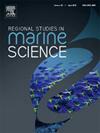Zooplankton in the Indian Sundarbans: Distribution, water parameters, threats and opportunities
IF 2.1
4区 环境科学与生态学
Q3 ECOLOGY
引用次数: 0
Abstract
Zooplankton plays crucial roles in the food web by transferring energy from primary producers to higher trophic levels. The Indian Sundarbans, being a large mangrove-estuarine ecosystem, harbors rich aquatic diversity but endures several threats from anthropogenic activities. The present review comprehensively summarizes the status of zooplankton in the Indian Sundarbans. This review discusses the distribution of zooplankton across rivers and tidal creeks/canals, the influences of water parameters, possible threats, and conservation proposals through potential long-term monitoring. Calanoid copepods (∼32.02 %) are predominant in the Indian Sundarbans, followed by Choreotrichida (∼17.8 %), Cyclopoida (∼8.67 %), Decapoda (∼7.55 %), and Harpacticoida (∼5.66 %). As per previous studies, calanoid Pseudodiaptomus serricaudatus is predominant in rivers, followed by Paracalanus parvus, Bestiolina similis, Acartia plumosa, and Acartiella tortaniformis. Salinity is the key water parameter influencing the assemblage and distribution of zooplankton in the Indian Sundarbans. Zooplankton in this region face several threats, such as pollution, natural disasters, and the development of river dykes, which may raise serious concerns about their survival. This review recommends conservation and long-term monitoring programs, including mass culture, database development, and the use of advanced techniques to support conservation policies for zooplankton communities. Special emphasis is given to habitat conservation and the implementation of river conservation programs like “Namami Gange” initiated by the Government of India. Additionally, this review outlines a baseline draft on zooplankton monitoring in the Indian Sundarbans, addressing sampling frequency, sampling locations, and possible funding opportunities for the smooth running of this program.
印度孙德尔本斯的浮游动物:分布、水体参数、威胁与机遇
浮游动物在食物网中发挥着至关重要的作用,它们将能量从初级生产者传递到更高的营养级。印度孙德尔本斯是一个大型红树林-河口生态系统,蕴藏着丰富的水生生物多样性,但也承受着来自人类活动的若干威胁。本综述全面总结了印度孙德尔本斯浮游动物的现状。本综述讨论了浮游动物在河流和潮汐小溪/运河中的分布、水体参数的影响、可能存在的威胁以及通过潜在的长期监测进行保护的建议。印度孙德尔本斯的浮游动物以桡足类(Calanoid copepods)为主(∼32.02 %),其次是栉水母纲(Choreotrichida)(∼17.8 %)、环足纲(Cyclopoida)(∼8.67 %)、十足目(Decapoda)(∼7.55 %)和栉水母纲(Harpacticoida)(∼5.66 %)。根据以往的研究,河流中的桡足类主要是伪二棘尾目(Pseudodiaptomus serricaudatus),其次是副桡足类(Paracalanus parvus)、桡足类(Bestiolina similis)、桡足类(Acartia plumosa)和桡足类(Acartiella tortaniformis)。盐度是影响印度孙德尔本斯浮游动物组合和分布的主要水体参数。该地区的浮游动物面临着多种威胁,如污染、自然灾害和河流堤坝的开发,这可能会严重影响它们的生存。本综述建议开展保护和长期监测计划,包括大规模培养、数据库开发和使用先进技术来支持浮游动物群落的保护政策。特别强调了栖息地保护和河流保护计划的实施,如印度政府发起的 "Namami Gange "计划。此外,本综述还概述了印度孙德尔本斯浮游动物监测基线草案,论述了采样频率、采样地点以及为使该计划顺利进行而可能提供的资助机会。
本文章由计算机程序翻译,如有差异,请以英文原文为准。
求助全文
约1分钟内获得全文
求助全文
来源期刊

Regional Studies in Marine Science
Agricultural and Biological Sciences-Ecology, Evolution, Behavior and Systematics
CiteScore
3.90
自引率
4.80%
发文量
336
审稿时长
69 days
期刊介绍:
REGIONAL STUDIES IN MARINE SCIENCE will publish scientifically sound papers on regional aspects of maritime and marine resources in estuaries, coastal zones, continental shelf, the seas and oceans.
 求助内容:
求助内容: 应助结果提醒方式:
应助结果提醒方式:


